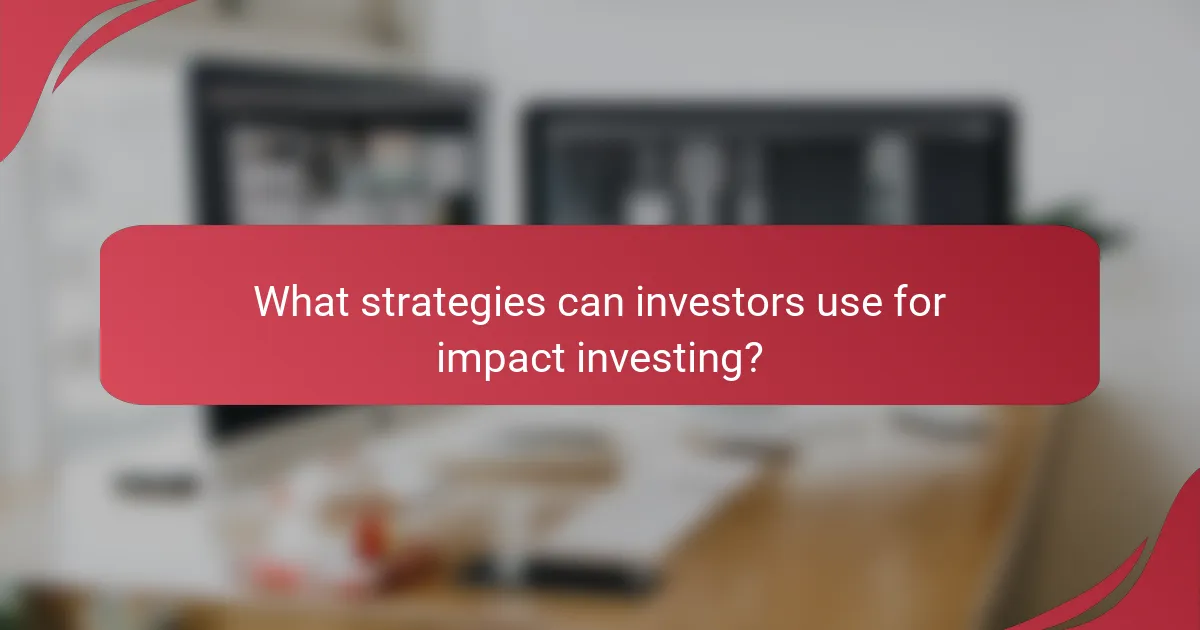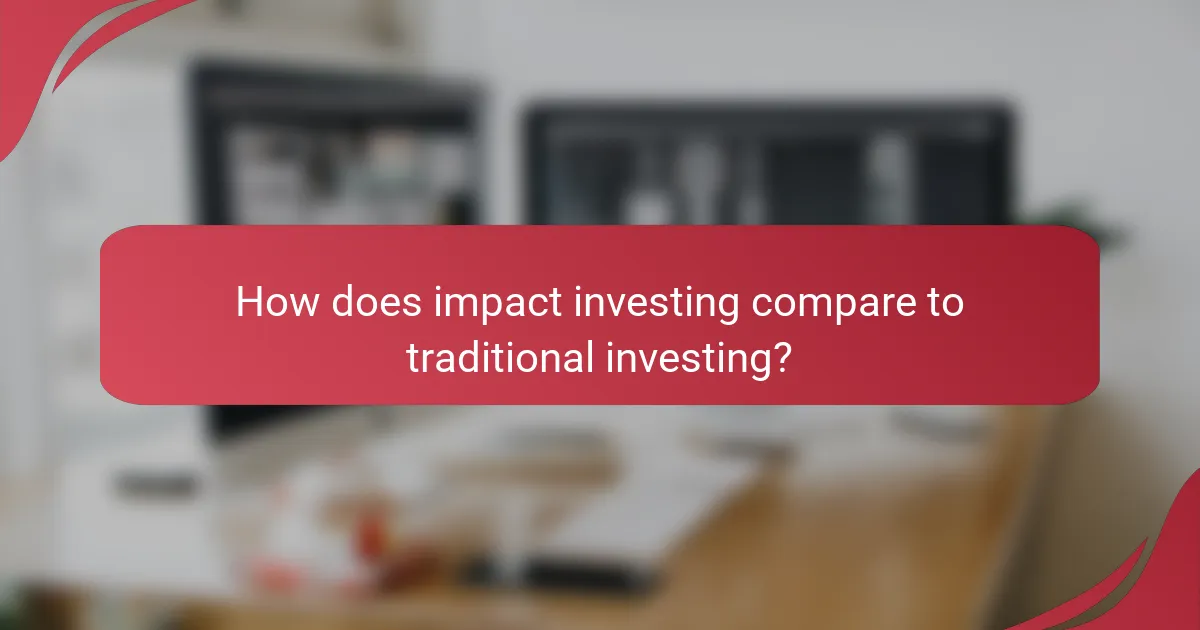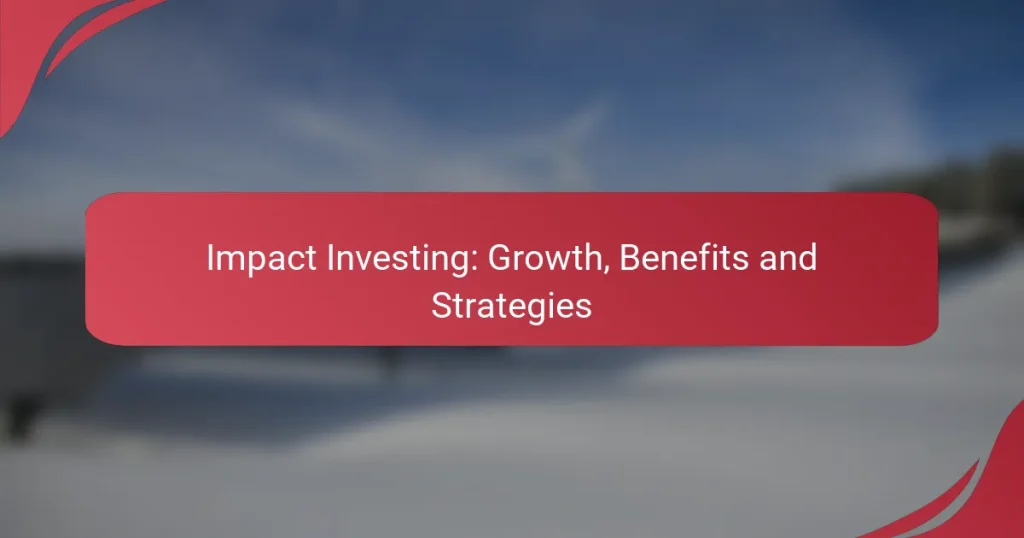Impact investing is a rapidly growing sector that allows investors to achieve financial returns while making a positive impact on social and environmental issues. This approach enables individuals and institutions to align their investments with their values, fostering a more purposeful financial strategy. Various strategies, such as direct investments in social enterprises and impact-focused funds, provide diverse opportunities for generating both profit and societal benefits.

What are the benefits of impact investing?
Impact investing offers a dual advantage of generating financial returns while contributing positively to social and environmental issues. Investors can align their financial goals with their values, leading to a more purposeful investment strategy.
Financial returns
Impact investing can yield competitive financial returns comparable to traditional investments. Many impact funds target a range of returns, often in the low to mid-teens percentage-wise, depending on the sector and risk profile. Investors should evaluate the financial performance of impact investments alongside their social objectives.
It’s essential to analyze the track record of impact funds and consider factors such as management fees and liquidity. Some impact investments may have longer time horizons, which can affect cash flow and overall returns.
Social impact
Investing with a social impact focus enables investors to support initiatives that address critical issues like poverty, education, and healthcare. By directing capital toward organizations that prioritize social outcomes, investors can help create meaningful change in communities.
To measure social impact, investors can use frameworks like the Global Impact Investing Network’s IRIS metrics or the Impact Management Project’s guidelines. These tools help assess the effectiveness of investments in achieving desired social goals.
Environmental sustainability
Impact investing plays a crucial role in promoting environmental sustainability by funding projects that address climate change, renewable energy, and resource conservation. Investors can support companies that prioritize eco-friendly practices and sustainable business models.
Investors should consider the environmental impact of their portfolios and seek out opportunities that align with sustainability goals. This may include investing in green bonds, clean technology, or companies with strong environmental, social, and governance (ESG) practices.
Portfolio diversification
Incorporating impact investments into a portfolio can enhance diversification by adding exposure to sectors that may not be represented in traditional investments. This can mitigate risk and provide access to emerging markets and innovative companies.
Investors should assess the correlation of impact investments with existing assets to optimize their portfolios. A well-diversified portfolio may include a mix of asset classes, including equities, fixed income, and alternative investments focused on social and environmental outcomes.
Attracting millennial investors
Impact investing is particularly appealing to millennial investors who prioritize ethical considerations alongside financial returns. This generation is increasingly seeking investments that reflect their values, making impact investing a strategic focus for fund managers.
To attract millennial investors, organizations should emphasize transparency, measurable impact, and alignment with social causes. Engaging with this demographic through social media and educational initiatives can also enhance interest in impact investment opportunities.

How is impact investing growing in the United States?
Impact investing is experiencing significant growth in the United States, driven by increasing awareness of social and environmental issues among investors. This trend reflects a shift towards prioritizing financial returns alongside positive societal impacts.
Increased capital flow
There has been a notable increase in capital flowing into impact investments, with many investors seeking opportunities that align with their values. This capital is often directed towards sectors such as renewable energy, affordable housing, and sustainable agriculture.
Institutional investors, including pension funds and endowments, are increasingly allocating a portion of their portfolios to impact investments. This trend is expected to continue as more investors recognize the potential for both financial returns and social benefits.
Emerging investment funds
New investment funds focused on impact investing are emerging across the United States, offering diverse options for investors. These funds often target specific themes, such as climate change or social equity, allowing investors to align their portfolios with their personal values.
Many of these funds utilize innovative financial instruments, such as social impact bonds and green bonds, to attract capital while addressing pressing social issues. Investors should research fund performance and alignment with their impact goals before committing capital.
Corporate social responsibility trends
Corporate social responsibility (CSR) is becoming a critical factor for businesses in the U.S., influencing their operational strategies and investment decisions. Companies are increasingly integrating impact investing principles into their CSR initiatives, recognizing the importance of sustainability and ethical practices.
As consumers demand more transparency and accountability, businesses are responding by investing in projects that deliver measurable social and environmental benefits. This trend not only enhances brand reputation but also attracts socially conscious investors looking for responsible investment opportunities.

What strategies can investors use for impact investing?
Investors can employ various strategies for impact investing, focusing on generating social and environmental benefits alongside financial returns. Key approaches include direct investments in social enterprises, impact-focused mutual funds, and community investment notes, each offering unique advantages and considerations.
Direct investments in social enterprises
Direct investments in social enterprises involve providing capital to businesses that prioritize social or environmental goals. This strategy allows investors to support innovative solutions to pressing issues, such as poverty alleviation or sustainable agriculture.
When considering direct investments, assess the enterprise’s mission, financial health, and potential for impact. Look for businesses with a clear plan for scaling their operations and measuring their social outcomes. Engaging with the management team can provide insights into their commitment and capacity for delivering on their promises.
Impact-focused mutual funds
Impact-focused mutual funds pool capital from multiple investors to invest in companies that meet specific social or environmental criteria. These funds typically focus on sectors like renewable energy, healthcare, or education, aiming to generate positive impact alongside competitive returns.
Investors should review the fund’s investment strategy, fees, and performance history. It’s essential to understand how the fund measures its impact and whether it aligns with your values. Consider funds that are transparent about their holdings and impact metrics to ensure accountability.
Community investment notes
Community investment notes are debt instruments that allow investors to support local initiatives while earning a return. These notes often fund projects in underserved communities, such as affordable housing or small business development.
When investing in community notes, evaluate the issuing organization’s track record and the specific projects being funded. Look for notes that offer clear terms, including interest rates and maturity periods. Be aware that while these investments can provide social returns, they may come with varying levels of risk and liquidity compared to traditional investments.

What criteria should investors consider in impact investing?
Investors in impact investing should focus on the alignment of their financial goals with measurable social or environmental outcomes. Key criteria include the clarity of impact objectives, the methods for measuring success, and the financial sustainability of the investment.
Measurable impact metrics
Measurable impact metrics are essential for assessing the effectiveness of an impact investment. Investors should look for clear indicators that quantify the social or environmental benefits, such as the number of people served, reduction in carbon emissions, or improvements in community health. Common frameworks include the Global Impact Investing Network’s IRIS metrics and the United Nations Sustainable Development Goals.
When evaluating metrics, consider both quantitative and qualitative data. For example, while a project may report saving a certain number of trees, qualitative testimonials from community members can provide deeper insights into the project’s overall impact. Establishing a baseline before investment is crucial for measuring progress over time.
Financial performance benchmarks
Financial performance benchmarks help investors gauge the viability of impact investments alongside traditional financial metrics. Investors should compare expected returns against industry standards, such as the average returns for private equity or venture capital in their region. This comparison can help determine if the investment is competitive while achieving its intended impact.
It’s important to recognize that impact investments may yield lower financial returns compared to conventional investments, especially in the early stages. Investors should be prepared for a range of returns, often in the single-digit to low double-digit percentages, depending on the sector and risk profile. Balancing financial performance with impact goals is key to successful impact investing.

How does impact investing compare to traditional investing?
Impact investing focuses on generating positive social or environmental outcomes alongside financial returns, while traditional investing primarily aims for profit maximization. Investors in impact funds often prioritize values and mission alignment, which can influence their investment choices and strategies.
Risk-return profiles
Impact investing typically presents different risk-return profiles compared to traditional investments. While traditional investments often target higher financial returns with varying levels of risk, impact investments may offer lower returns in exchange for social or environmental benefits. This trade-off can appeal to investors who value purpose alongside profit.
For example, a traditional equity investment might aim for annual returns in the high single digits to low double digits, while an impact investment focused on renewable energy might yield returns in the mid-single digits. Understanding these profiles helps investors align their financial goals with their values.
When considering risk-return profiles, investors should assess their own risk tolerance and investment horizon. A diversified portfolio that includes both traditional and impact investments can balance potential returns with social impact, allowing for a more holistic investment approach.


